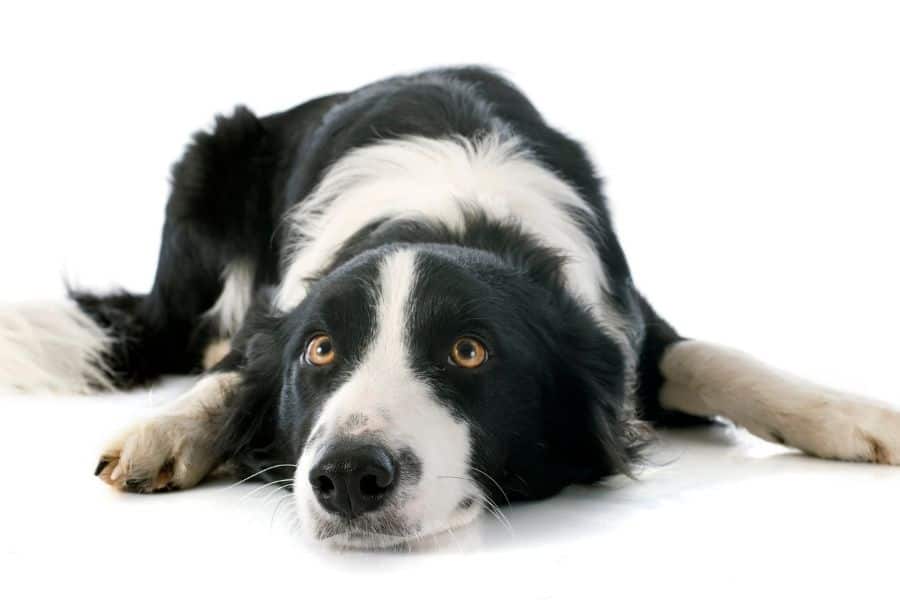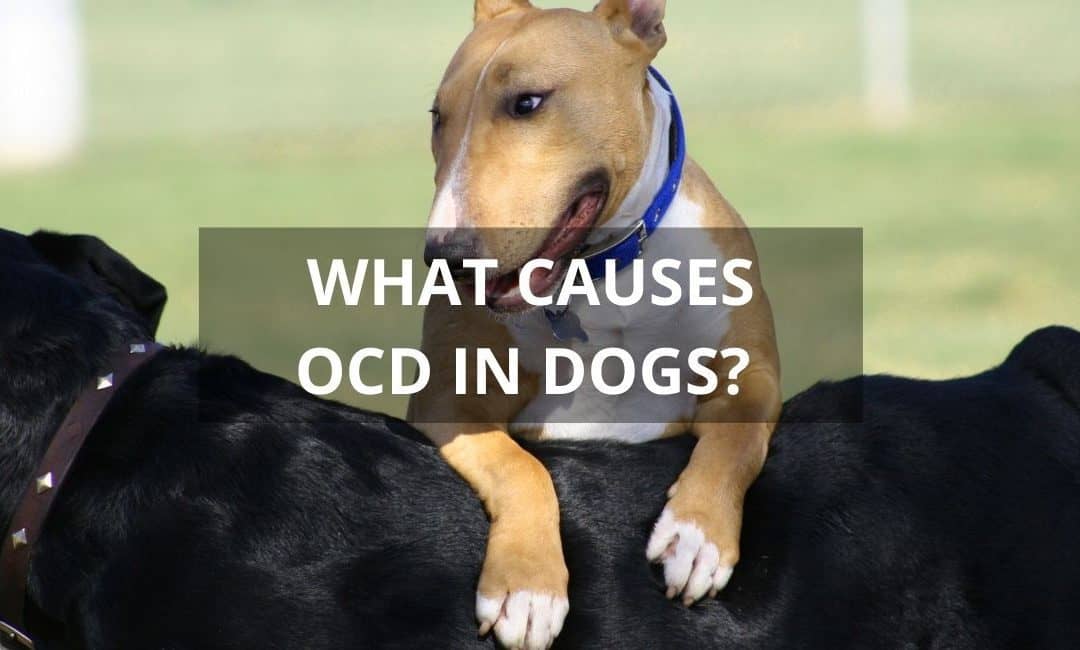Compulsive and repetitive behaviors in dogs don’t develop randomly. Although genetics can be a strong predetermining factor, it’s only one of a variety that can contribute to the development of OCD in dogs.
Your dog’s temperament and personality contribute to his susceptibility to OCD. The environment he lives in, and your social and lifestyle habits can figure in.
Even the quality of your relationship with your dog can make him more – or less – susceptible to developing OCD.
And then there are the specific triggers that can bring on OCD episodes. Their presence (or absence), and your dog’s access to them (or lack thereof) can help determine whether your dog develops compulsive behaviors or not.
Let’s look at each one of these in turn.
Canine personality types more prone to OCD
Most dogs prone to compulsive behaviors are excitable, high strung, and impulsive by nature. However, the likelihood of developing OCD behaviors goes beyond whether a dog is high strung or not.
The stability of your dog’s temperament is a crucial factor. Balanced, stable temperaments are much more resistant to developing compulsive disorders. Less stable temperaments do not handle stressful pressure as well, and as a result, can be more susceptible to OCD.
In people, strong territorial instincts have been linked to compulsive behaviors. While we don’t know for sure if this is also true also for dogs, it may well be a factor.
The three primary factors associated with OCD in dogs:
- Excitability
- An anxious, insecure nature
- Poor ability to handle stress

Dog breeds more susceptible to OCD
Some dog breeds simply have a stronger predisposition to compulsive disorders. Bull Terriers are known for whirling and tail chasing, as are some German Shepherds. Labrador Retrievers can be prone to compulsive eating, pica (eating of non-food items), and compulsive licking of limbs. Dobermans can be prone to flank sucking.
Of course, not every dog within these breeds will have OCD tendencies. In fact, the percentage susceptible is usually small.
How can you know if your dog might be prone to OCD?
Typically, certain genetic lines (AKA pedigrees) within each breed will have a stronger predisposition than the breed on average.
Because of this, it pays to make thorough inquiries about any family history of compulsive behavior if you’re considering purchasing a dog from one of these breeds.
Dogs of breeds that were developed to perform a job (like herding, protection, and hunting breeds), tend to be highly active both mentally and physically.
To remain stable and balanced, these dogs need an outlet for their drive and intensity.
Without the training, environment, and social activities they need to stay stable and balanced, “unemployed†working dogs can be more susceptible to developing OCD behaviors.

Factors that can contribute to OCD in dogs
Whether or not a particular factor affects your dog will depend his temperament and experience, but also on whether he’s subject to one, a few, or several contributing factors on an ongoing basis.
In general, OCD behaviors in dogs can become exaggerated under the influence of:
- Chronic stress
- Chronic frustration and stressful arousal
- Environmental stress & conflict
- Social stress and conflict
Environmental factors
All dogs benefit from room to explore and investigate an interesting, varied home environment. What is “adequate†will vary from dog to dog, however.
Dogs that are more physically active and mentally driven will need a more rich and varied environment, not to mention opportunities for exercise and mental stimulation, than dogs bred to be low-key companions.
What does this mean for compulsive behavior tendencies?
A very passive, easy going, low-drive dog will generally be able to handle more OCD stress factors than an impulsive, intense, high drive dog.
Basically the more drive the dog has, the greater the need to express it. If the need is greater than their opportunity to fulfill it, dogs can become susceptible to stress and triggers building up.
Environmental stress factors for OCD in dogs:
- Inadequate space
- Sterile, monotonous living environment
- Sensory deprivation (boredom, inadequate exercise)
- Lack of predictability in the environment. (For example, what’s safe in the dog’s environment today may not be tomorrow. This creates uncertainty and anxiety.)
Lifestyle factors
Lifestyle stress factors that can contribute to compulsive behavior are:
- Inadequate exercise. Remember what is adequate will depend on age, breed, and individual dog.
- Intellectual deprivation. Lack of adequate functional mental work, (i.e. a “job to doâ€), lack of outlet for the dog’s need to work with its owner (particularly in working breeds).
- Lack of outings (especially with territorial-related behaviors). Dogs that spend most or all of their time exclusively in one area tend to develop stronger territorial reactions than dogs that take frequent trips out of the area. This is especially problematic if the territory is routinely challenged by visitors, passers-by, wandering animals, etc.
- Lack of predictability to, and control over, interactions. (Anxiety is created when the rules of life change from day to day. Dogs must have a clear sense of how to succeed in their relationships and interactions with others.)
Social & Relationship factors
Social stress & conflict is a major contributor to compulsive behavior in dogs. This may result from:
Inadequate social attention. All dogs, even those of the more aloof and independent breeds, are social animals. Forming sound social relationships is part of their genetic makeup, and should never be neglected.
Early removal from mother. Puppies taken away too early from their dam can develop chronic blanket sucking and kneading. Interestingly, this behavior may not appear until puberty.
Unbalanced relationships. Lack of balance can stem from:
- Fear and/or conflict resulting from overly emotional and/or heavy-handed punishments, especially when inconsistently or unpredictably meted out.
- Lack of leadership and structure. Dogs need to understand how to succeed in their family and environment. Absent leadership and structure put the responsibility on the dog’s shoulders, which is not just unfair, but more pressure than many dogs can handle.
- Excessive emotional attachment to owner. Dogs that become over-attached to one person are less flexible emotionally and more dependent on a very limited range of emotional feedback.
- Overly emotional social environment. Dogs are typically not wired to handle high levels of human emotion, unpredictable emotion, etc. An intensely emotional, or unpredictably emotional social environment can be a factor in development of compulsive behavior.
Specific triggers for OCD episodes in dogs
There are, no doubt, a huge variety of specific triggers for compulsive behavior episodes in dogs. However, most OCD triggers can be grouped into the following types:
- Fear triggering events: approach of certain individuals, interaction with certain individuals, anticipated correction.
- Conflict and/or arousal triggering situations and events: arrivals, departures, encroachments on territory, feeding times.
- Arousal triggering places – barriers (gates, doors, crates, fence lines).
- Attention seeking, desire to work for, engage with owner.
- Anxious attachment to owner.
